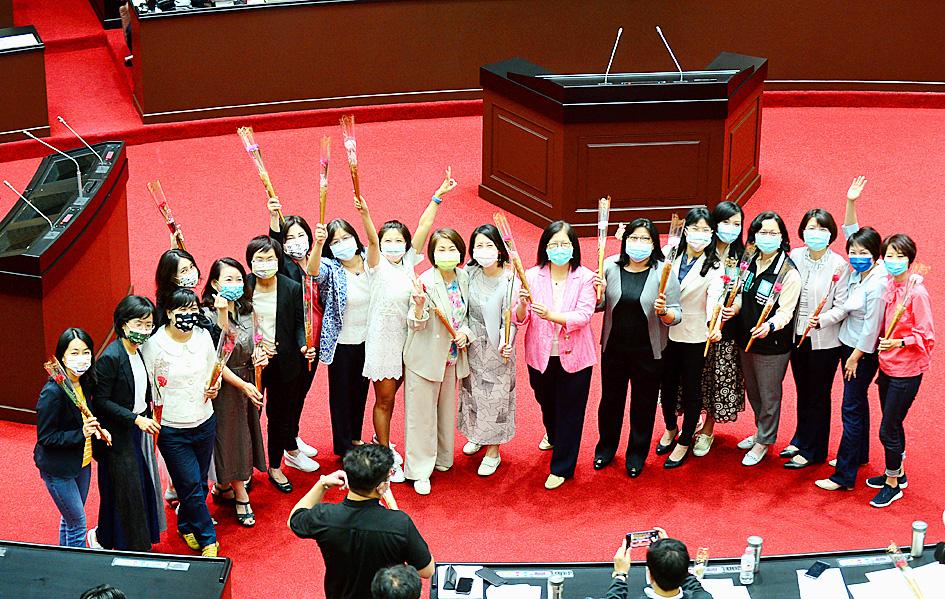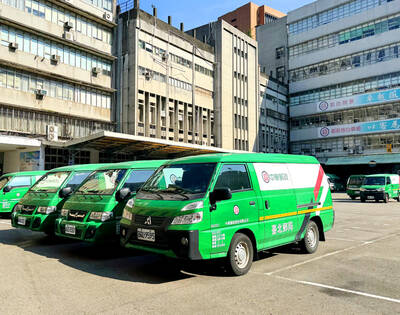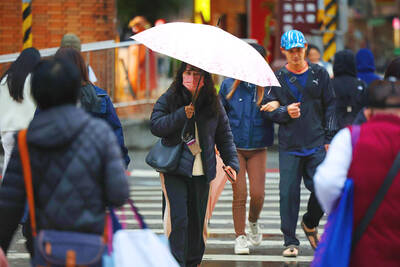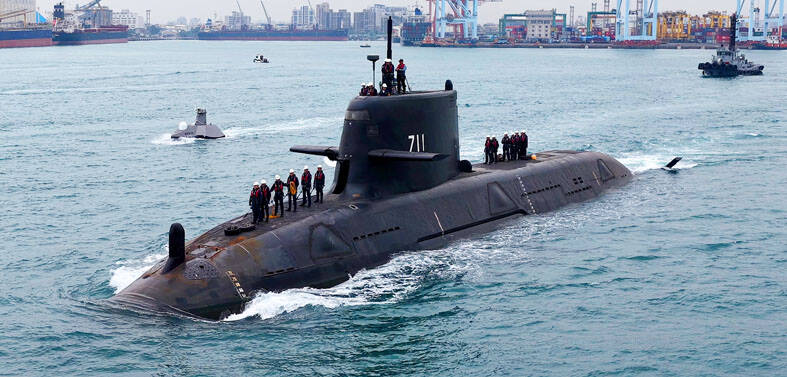Taiwan leads East Asian countries in gender equality of legislatures with the highest ratio of female to male lawmakers, the Executive Yuan’s Gender Equality Committee (GEC) said in a statement yesterday.
Female lawmakers in Taiwan accounted for 41.6 percent of the Legislative Yuan in 2020, and rose to 42.5 percent this month, when Democratic Progressive Party Legislator Lin Ching-yi (林靜儀) won a legislative by-election in Taichung’s second district, the committee said.
The updated figure is a new record and places Taiwan ahead of other countries in Asia, including Singapore and South Korea, the committee added.

Photo: Wang Yi-sung, Taipei Times
The United Arab Emirates has the highest proportion of female lawmakers in Asia (50 percent), and the third-highest in the world, the committee said in its report titled Gender At A Glance in the Republic of China (Taiwan), which it released yesterday.
Aside from an increase in female lawmakers, the proportion of female judges and the proportion of female ministers without portfolio have exceeded 50 percent, the report said.
In 2020, Taiwan also recorded the highest rate of female participation in the workforce in a decade among women aged 45 to 64 — 52.3 percent — while the percentage of women of all ages in the labor force rose by 1.5 percentage points to 51.4 percent from 2010 to 2020, it said.
During the same period, the percentage of men in the labor force rose 0.7 percentage points to 67.2 percent, it added.
In 2020, the average wage gap between male and female workers was 14.8 percent, 0.1 percentage points lower than a year earlier, it said.
However, gender bias remains prevalent in industries historically dominated by men, it said.
For example, in the construction industry, the percentage of registered female architects who applied to open their own firms was 8.46 percent, it said.
Further education and improvement in “personal safety and justice” are also needed, the report said, adding that females were victims in 80.4 percent of the 9,212 sexual assault cases reported in 2020.
Since 2020, the percentage of sexual assaults with female victims has increased, with 70 percent of sexual harassment and assault cases on school campuses involving women, it said.

NUMBERS IMBALANCE: More than 4 million Taiwanese have visited China this year, while only about half a million Chinese have visited here Beijing has yet to respond to Taiwan’s requests for negotiation over matters related to the recovery of cross-strait tourism, the Tourism Administration said yesterday. Taiwan’s tourism authority issued the statement after Chinese-language daily the China Times reported yesterday that the government’s policy of banning group tours to China does not stop Taiwanese from visiting the country. As of October, more than 4.2 million had traveled to China this year, exceeding last year. Beijing estimated the number of Taiwanese tourists in China could reach 4.5 million this year. By contrast, only 500,000 Chinese tourists are expected in Taiwan, the report said. The report

SHIPS, TRAINS AND AUTOMOBILES: The ministry has announced changes to varied transportation industries taking effect soon, with a number of effects for passengers Beginning next month, the post office is canceling signature upon delivery and written inquiry services for international registered small packets in accordance with the new policy of the Universal Postal Union, the Ministry of Transportation and Communications said yesterday. The new policy does not apply to packets that are to be delivered to China, the ministry said. Senders of international registered small packets would receive a NT$10 rebate on postage if the packets are sent from Jan. 1 to March 31, it added. The ministry said that three other policies are also scheduled to take effect next month. International cruise ship operators

Temperatures are forecast to drop steadily as a continental cold air mass moves across Taiwan, with some areas also likely to see heavy rainfall, the Central Weather Administration (CWA) said. From today through early tomorrow, a cold air mass would keep temperatures low across central and northern Taiwan, and the eastern half of Taiwan proper, with isolated brief showers forecast along Keelung’s north coast, Taipei and New Taipei City’s mountainous areas and eastern Taiwan, it said. Lows of 11°C to 15°C are forecast in central and northern Taiwan, Yilan County, and the outlying Kinmen and Lienchiang (Matsu) counties, and 14°C to 17°C

STEERING FAILURE: The first boat of its class is experiencing teething issues as it readies for acceptance by the navy, according to a recent story about rudder failure The Hai Kun (海鯤), the nation’s first locally built submarine, allegedly suffered a total failure of stern hydraulic systems during the second round of sea acceptance trials on June 26, and sailors were forced to manually operate the X-rudder to turn the submarine and return to port, news Web site Mirror Daily reported yesterday. The report said that tugboats following the Hai Kun assisted the submarine in avoiding collisions with other ships due to the X-rudder malfunctioning. At the time of the report, the submarine had completed its trials and was scheduled to begin diving and surfacing tests in shallow areas. The X-rudder,